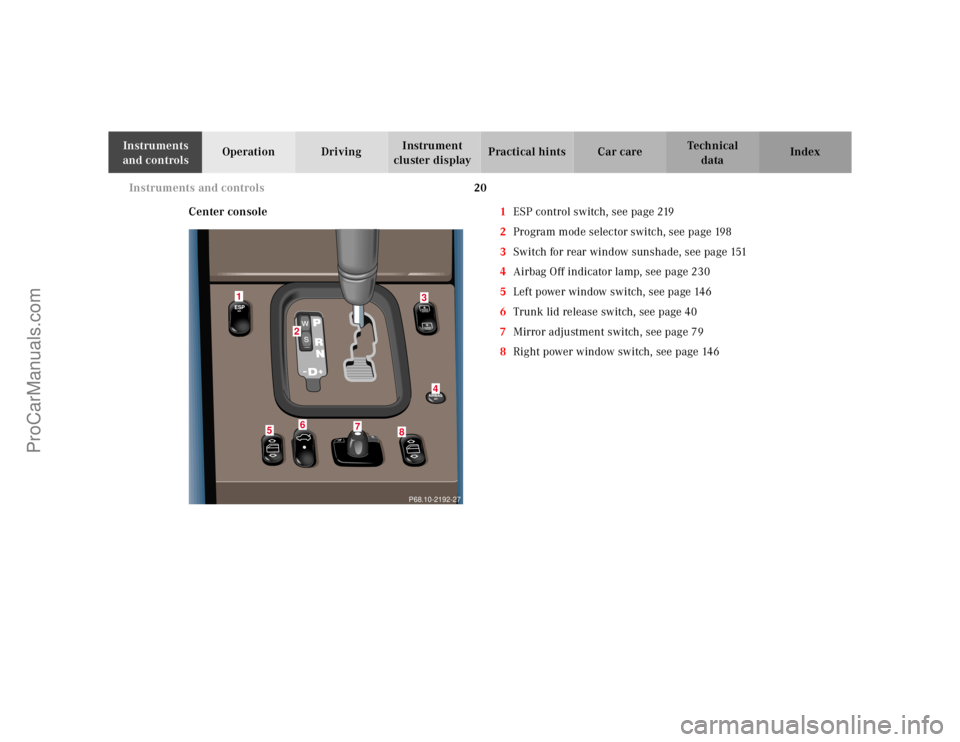2001 MERCEDES-BENZ CLK-CLASS ESP
[x] Cancel search: ESPPage 6 of 325

3 Contents
DrivingControl and operation of
radio transmitters ..................... 174
The first 1 000 miles
(1 500 km) ................................. 175
Maintenance ................................... 175
Catalytic converter ........................ 176
Emission control ............................ 177
Tele Aid ........................................... 178
Steering lock ................................... 188
Starting and turning off
the engine .................................. 190
Automatic transmission ............... 191
Parking brake .................................200
Driving instructions ......................201
Drive sensibly – save fuel .........201
Drinking and driving ................. 201
Pedals ........................................... 201
Power assistance ........................202Brakes .......................................... 202
Driving off ................................... 203
Parking ........................................ 203
Tires ............................................. 204
Snow chains ............................... 206
Winter driving instructions ..... 207
Winter driving ............................ 208
Deep water .................................. 208
Passenger compartment ........... 209
Traveling abroad ........................ 209
Cruise control .................................210
Brake assist system
(BAS) ...........................................213
Antilock brake system
(ABS) ...........................................215
Electronic stability program
(ESP) ............................................217
What you should know
at the gas station ...................... 221
Check regularly and
before a long trip ...................... 223
Instrument cluster displayMalfunction and
indicator lamps in the
instrument cluster ....................226
On-board diagnostic system
Check engine malfunction
indicator lamp .............................226
Brake warning lamp ..................227
Supplemental restraint system
(SRS) indicator lamp ..................228
Fuel reserve and fuel cap
placement warning ....................228
Electronic stability program
(ESP) — warning lamp ...............229
BAS/ESP malfunction
indicator lamp .............................229
ABS malfunction
indicator lamp .............................229
Telescoping steering column –
indicator lamp .............................230
Seat belt warning lamp .............230
ProCarManuals.com
Page 10 of 325

7 IntroductionProduct information
Kindly observe the following in your own best interest:
We recommend using Mercedes-Benz original parts as well as conversion parts and accessories
explicitly approved by us for your vehicle model.
We have tested these parts to determine their reliability, safety and their special
suitability for Mercedes-Benz vehicles.
We are unable to make an assessment for other products and therefore cannot be held responsible
for them, even if in individual cases an official approval or authorization by governmental or other
agencies should exist. Use of such parts and accessories could adversely affect the safety, performance
or reliability of your vehicle. Please do not use them.
Mercedes-Benz original parts as well as conversion parts and accessories approved by us are available
at your authorized Mercedes-Benz Center where you will receive comprehensive information, also on
permissible technical modifications, and where proper installation will be performed.
ProCarManuals.com
Page 23 of 325

20 Instruments and controls
Te ch n ica l
data Instruments
and controlsOperation DrivingInstrument
cluster displayPractical hints Car care Index
Center console1ESP control switch, see page 219
2Program mode selector switch, see page 198
3Switch for rear window sunshade, see page 151
4Airbag Off indicator lamp, see page 230
5Left power window switch, see page 146
6Trunk lid release switch, see page 40
7Mirror adjustment switch, see page 79
8Right power window switch, see page 146
P68.10-2192-27
2
5
1
6
7
8
43
ProCarManuals.com
Page 36 of 325

33 Central locking system
Te ch n ica l
data Instruments
and controlsOperationDrivingInstrument
cluster displayPractical hints Car care Index Panic button
To activate press and hold button (1) for at least one
second. An audible alarm and blinking exterior lamps
will operate for approximately 3 minutes.
To deactivate press button (1) again, or insert electronic
key in steering lock.Note:
For operation in the USA only: This device complies
with Part 15, Subpart C, Section 209 of the FCC Rules.
Operation is subject to the following two conditions:
(1) This device may not cause harmful interference, and
(2) this device must accept any interference received,
including interference that may cause undesired
operation.
WARNING: Changes or modification not expressly
approved by party responsible for compliance could void
the user’s authority to operate the equipment.
Mechanical keys
The mechanical keys work only in the driver’s door,
trunk, and storage compartment locks.
Notes:
The mechanical key does not operate the central locking
system or antitheft alarm system.
The fuel filler flap cannot be locked or unlocked with
the mechanical key.
P80.35-2035-26
1
ProCarManuals.com
Page 51 of 325

48 Seats
Te ch n ica l
data Instruments
and controlsOperationDrivingInstrument
cluster displayPractical hints Car care Index
Memory storing and recalling
6Memory button
7Position buttonsStoring
Three sets of seat/head restraint and exterior rear view
mirror positions may be programmed into memory.
After the seat/head restraint and exterior rear view
mirrors are positioned, push memory button (6),
release, and within 3 seconds push position button “1”.
A second and third set of positions for the same seat/
head restraint and exterior rear view mirrors can be
programmed into memory by pushing first memory
button (6) and then “2”, respectively “3”.
Note:
See page 79 for instructions on adjustment of mirrors.
ProCarManuals.com
Page 52 of 325

49 Seats
Te ch n ica l
data Instruments
and controlsOperationDrivingInstrument
cluster displayPractical hints Car care Index Recalling
To recall a seat/head restraint and exterior rear view
mirror position, push and hold position button “1”, “2”
or “3” until seat/head restraint and exterior rear view
mirror movement has stopped. The seat/head restraint
and exterior rear view mirror movement stops when the
position button is released.
Caution!
Do not operate the power seats using the memory
button if the seat backrest is in an excessively reclined
position. Doing so could cause damage to front or rear
seats.
First move the backrest to an upright position.Synchronizing power seats and head restraints
If the power supply was interrupted (battery
disconnected or empty), the power seats and head
restraints are no longer adjusted automatically.
To resynchronize the adjustment feature, turn
electronic key in steering lock to position 2, move the
seat completely forward and the head restraint fully
down, and hold respective buttons for approx.
2 seconds.
ProCarManuals.com
Page 74 of 325

71 Restraint systems
Te ch n ica l
data Instruments
and controlsOperationDrivingInstrument
cluster displayPractical hints Car care Index
• Sit properly belted in an upright position with
your back against the backrest.• Adjust the driver’s seat as far as possible
rearward, still permitting proper operation of
vehicle controls. The distance from the center
of the driver’s breastbone to the center of the
airbag cover on the steering wheel must be at
least ten inches (25 cm) or more. You should be
able to accomplish this by a combination of
adjustments to the seat and steering wheel. If
you have any problems, please see your
authorized Mercedes-Benz Center.• Do not lean with your head or chest close to the
steering wheel or dashboard.• Keep hands on the outside of steering wheel
rim. Placing hands and arms inside the rim
can increase the risk and potential severity of
hand/arm injury when the driver front airbag
inflates.• Adjust the front passenger seat as far as
possible rearward from the dashboard when
the seat is occupied.
• Occupants, especially children, should never
lean their heads in the area of the door where
the side airbag inflates. This could result in
serious injuries or death should the airbag be
triggered. Always sit upright, properly use the
seat belts, and appropriate size infant or child
restraint system.• Children 12 years old and under must never
ride in the front seat, except in a
Mercedes-Benz authorized BabySmart
TM
compatible child seat, which operates with the
BabySmart
TM system installed in the vehicle to
deactivate the passenger front airbag when it
is properly installed. Otherwise they will be
struck by the airbag when it inflates in a crash.
If this happens, serious or fatal injury can
result.
Failure to follow these instructions can result in
severe or fatal injuries to you or other occupants.
ProCarManuals.com
Page 75 of 325

72 Restraint systems
Te ch n ica l
data Instruments
and controlsOperationDrivingInstrument
cluster displayPractical hints Car care Index
Safety guidelines for the seat belt,
emergency tensioning retractor and airbag
Wa r n i n g !
Accident research shows that the safest place for
children in an automobile is in the rear seat.
Should you choose to place a child 12 years old or
under in the front passenger seat of your vehicle,
you must properly use a BabySmart
TM child
restraint which will turn off the passenger side
front airbag. BabySmart
TM will not, however, turn
off the passenger’s side impact airbag.
It should be noted however that there is a
possibility for a side airbag related injury if
occupants, especially children, are not properly
seated or restrained when next to a side airbag
which needs to deploy rapidly in a side impact in
order to do its job.To help avoid the possibility of injury, please follow
these guidelines: (1) occupants, especially
children, should never place their bodies or lean
their heads in the area of the door where the side
airbag inflates. This could result in serious
injuries or death should the side airbag be
activated; (2) always sit upright, properly use the
seat belts and use an appropriately sized infant or
child restraint system for all children 12 years old
or under; and (3) always wear seat belts properly.
Wa r n i n g !
• Damaged seat belts or belts that were highly
stressed in an accident must be replaced and
their anchoring points must also be checked.
Use only belts installed or supplied by an
authorized Mercedes-Benz Center.• Do not pass belts over sharp edges.• Do not make any modification that could
change the effectiveness of the belts.• Airbags and ETR’s are designed to function on
a one-time-only basis. An airbag or emergency
tensioning retractor (ETR) that was activated
must be replaced.
ProCarManuals.com